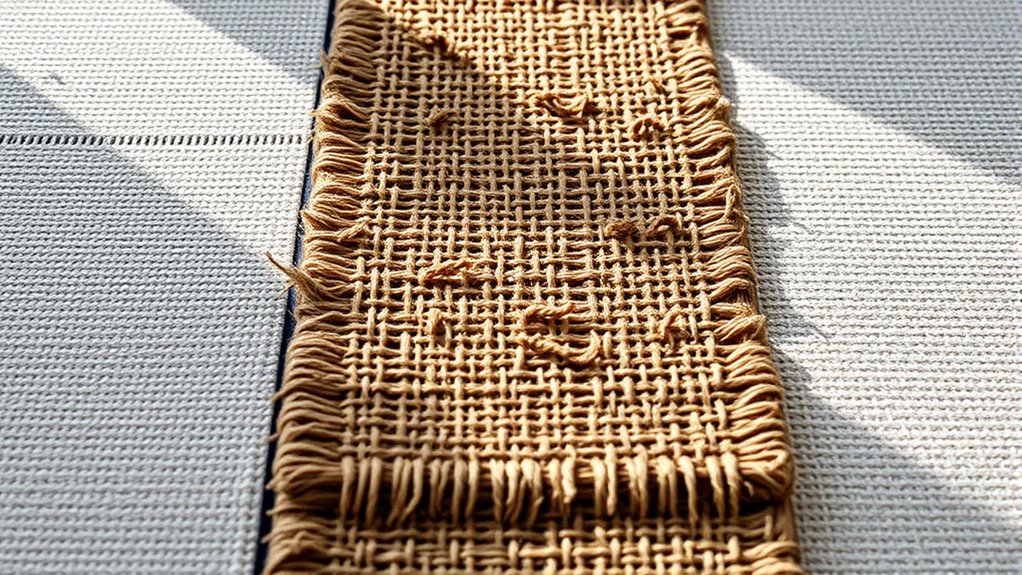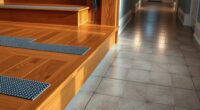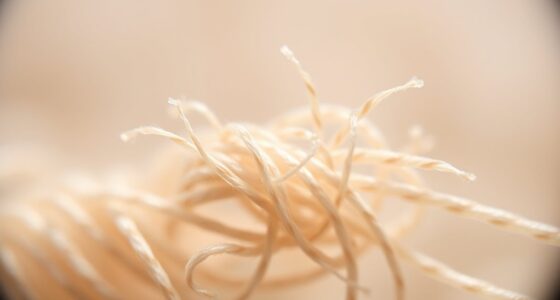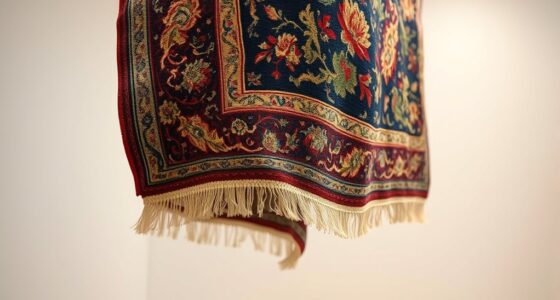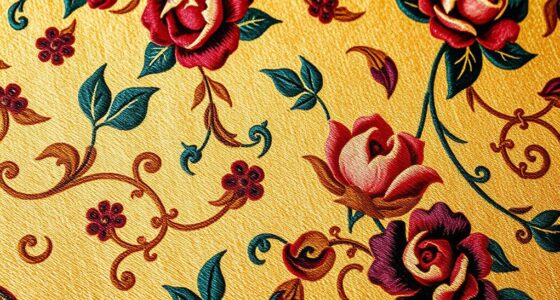When comparing rug backings, cotton offers softness, breathability, and eco-friendliness, making it great for comfort and ease of cleaning. Jute provides a natural, textured look with good durability, ideal for rustic or eco-conscious styles, but it’s susceptible to moisture damage. Latex is highly durable and offers excellent slip resistance and cushioning, perfect for high-traffic areas. To discover which backing best suits your space and needs, see how each one performs under different conditions.
Key Takeaways
- Cotton backing offers softness, breathability, and eco-friendliness but may wear faster under heavy traffic.
- Jute backing provides a natural, textured look with good initial strength but is susceptible to moisture and fraying.
- Latex backing is highly durable, slip-resistant, and cushions impact, ideal for high-traffic areas.
- Cotton and jute are biodegradable and environmentally friendly, while latex’s sustainability depends on its source.
- Maintenance varies: cotton and jute require careful moisture management, whereas latex is resistant to wear and tear.
Overview of Rug Backing Materials
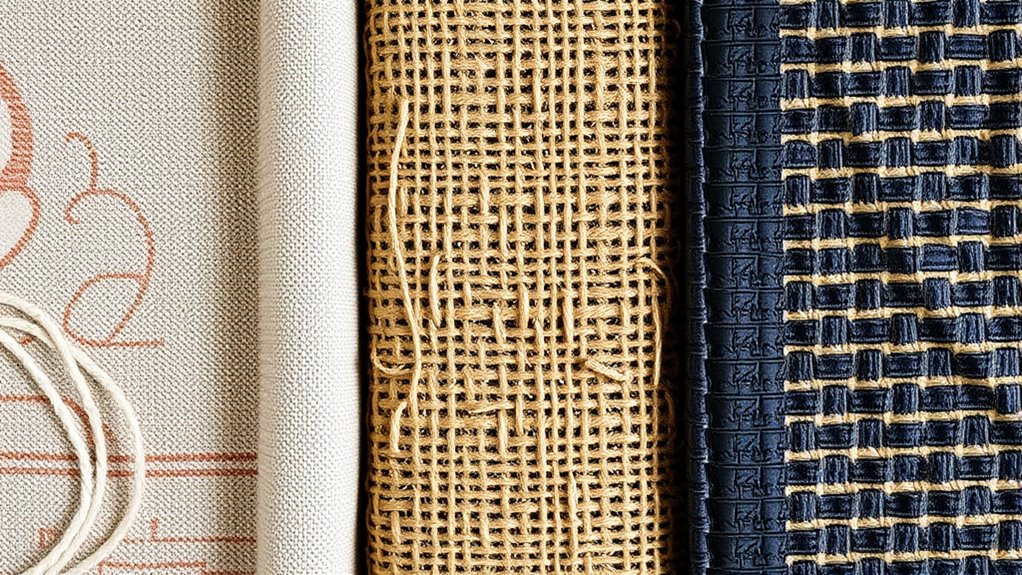
Have you ever wondered what holds a rug together and keeps it in place? Rug backing materials serve as the foundation, providing support and stability. Common options include cotton, jute, and latex, each with unique properties. Cotton backing is soft, durable, and easy to clean, making it suitable for many residential rugs. Jute backing is natural and eco-friendly, offering a rustic look and good breathability. Latex, on the other hand, is a synthetic material that provides excellent grip and flexibility, often used in non-slip rugs. The choice of backing depends on your needs, such as durability, eco-friendliness, or slip resistance. Understanding these materials helps you select the right rug to meet your lifestyle and aesthetic preferences. Additionally, considering the spiritual significance of materials can enhance your connection to your environment and personal well-being.
Characteristics of Cotton Backing
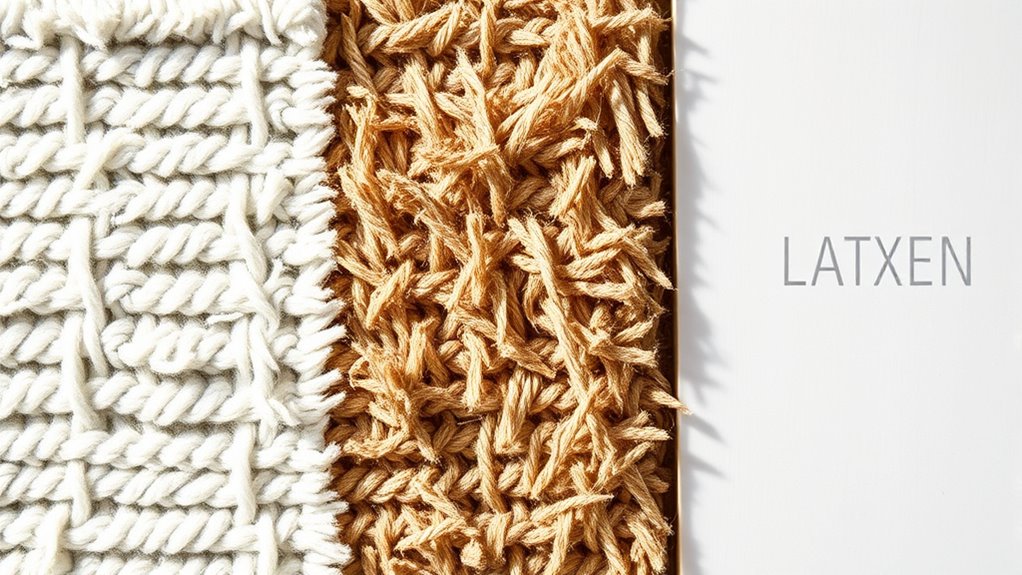
Cotton backing offers excellent breathability and comfort, making your rug feel softer and more natural underfoot. It’s also known for being durable and easy to maintain, so your rug stays looking good over time. Understanding these characteristics helps you choose the right backing for your needs. Additionally, cotton backing is environmentally friendly and biodegradable, aligning with sustainable camping practices.
Breathability and Comfort
Because of its natural fibers, cotton backing allows air to flow freely, making it highly breathable. This helps prevent moisture buildup and keeps your space feeling fresh. Cotton’s soft texture also adds to overall comfort, reducing irritation if you walk barefoot on the rug. Its flexibility means it adapts easily to your floor’s contours, enhancing stability. Additionally, cotton’s family photoshoot fails often include humorous moments, reflecting its versatile and natural qualities. With cotton backing, you’ll notice: – Improved air circulation, reducing mustiness – Enhanced comfort underfoot – Better temperature regulation, especially in warm climates
Choosing cotton backing not only improves your rug’s breathability but also creates a cozy, inviting atmosphere. Its natural qualities make it a top pick for those prioritizing comfort and freshness in their living spaces.
Durability and Maintenance
While cotton backing offers many benefits, it also requires proper care to maintain its durability. Cotton is relatively sturdy, but it can weaken or fray if exposed to excessive moisture or rough handling. To keep it in good shape, avoid soaking the backing or exposing it to direct sunlight for long periods, which can cause fading and fiber breakdown. Regularly vacuum your rug gently to remove dirt and debris that can cause wear over time. If it becomes stained or dirty, spot clean with mild soap and cold water; avoid harsh chemicals. When cleaning or moving your rug, lift it carefully rather than dragging it. Proper maintenance guarantees your cotton-backed rug remains durable, comfortable, and visually appealing for years to come. Understanding rug construction can help you better care for and extend the lifespan of your rug.
Benefits of Jute Backing
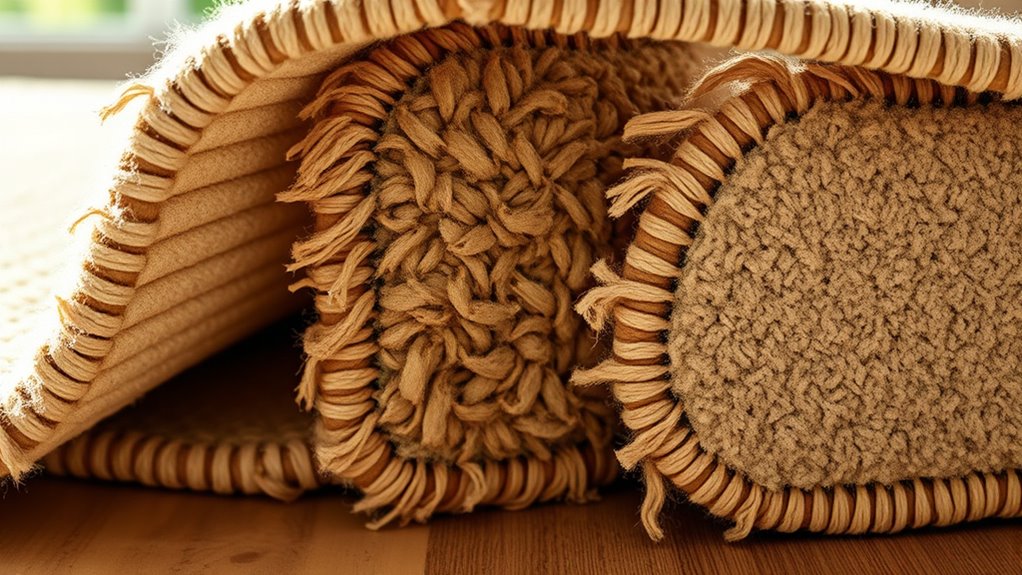
Jute backing offers several advantages that make it a popular choice for rug construction. Its natural fibers provide excellent breathability, helping your rug stay fresh and preventing moisture buildup. Jute is eco-friendly, as it’s biodegradable and sustainable, reducing environmental impact. Additionally, jute adds a rustic, textured look that enhances your rug’s aesthetic appeal. When choosing jute backing, you benefit from:
Jute backing is breathable, eco-friendly, and adds a rustic, natural charm to your rug.
- Enhanced breathability and moisture regulation
- Eco-conscious, biodegradable materials
- Unique, natural texture that complements various decor styles
- Mindfulness can be practiced during rug selection to help you appreciate natural materials and make thoughtful choices.
These qualities make jute a practical and stylish backing option, especially if you value sustainability and natural aesthetics. Its versatility ensures your rug remains functional and attractive over time, blending well with different interior designs while supporting environmentally friendly choices.
Features of Latex Backing
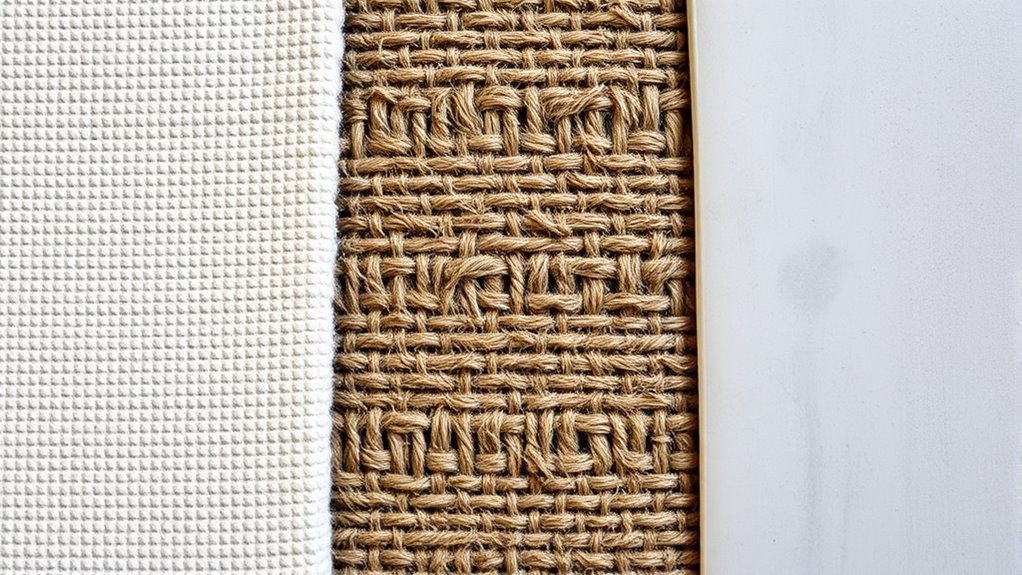
Latex backing offers impressive durability and a long lifespan, making your rug more resistant to wear. It also provides excellent cushioning, adding comfort underfoot. Plus, latex is eco-friendly, so it’s a sustainable choice for environmentally conscious homeowners. Additionally, latex backing can enhance product performance by maintaining the integrity of the rug over time.
Durability and Longevity
Latex-backed rugs are known for their impressive durability and long-lasting performance. They resist wear and tear better than other backings, making them ideal for high-traffic areas. The latex layer provides a strong grip on the floor, preventing slipping and shifting over time. With proper care, these rugs can last for years without showing significant signs of deterioration. Additionally, latex backing maintains its flexibility, preventing cracking or breaking down under pressure. To maximize longevity, consider these factors:
- Latex’s resistance to moisture helps prevent mold and mildew buildup.
- Its elasticity adapts to foot traffic, reducing damage caused by stretching or compression.
- The inherent durability minimizes fraying or peeling, keeping your rug intact for the long haul.
- Automation in industry is increasingly used to enhance manufacturing processes and ensure consistent quality.
Cushioning and Comfort
Because of its natural elasticity, latex backing provides a cushioned feel underfoot that enhances comfort. It absorbs shock and reduces pressure points, making walking or standing on the rug more pleasant. Latex’s flexible nature conforms slightly to your foot’s pressure, offering a soft, supportive layer. This padding helps prevent fatigue, especially in high-traffic areas. Unlike thinner backings, latex maintains its resilience over time, ensuring consistent comfort. It also dampens noise and vibrations, contributing to a quieter, more comfortable environment. You’ll notice a plush, supportive sensation that makes your space feel inviting and cozy. Overall, latex backing combines cushioning with stability, giving your rug a luxurious feel that elevates your everyday experience. Additionally, latex’s durability ensures that the cushioning effect remains consistent even after extended use.
Environmental Impact
While latex backing offers notable cushioning and comfort, it’s also important to contemplate its environmental impact. Natural latex is derived from rubber tree sap, making it a renewable resource. However, the manufacturing process can involve significant energy use and the use of chemicals that may harm ecosystems. Additionally, the disposal of latex can pose challenges, as it doesn’t biodegrade as quickly as natural fibers. You should consider these factors when evaluating latex’s sustainability.
- *Renewable resource but energy-intensive production*
- *Chemicals used in manufacturing may harm ecosystems*
- *Limited biodegradability, affecting waste management*
Furthermore, increased consumer awareness of eco-friendly grooming practices is influencing the demand for more sustainable materials in various industries, including home furnishings like rugs.
Durability and Wear Resistance
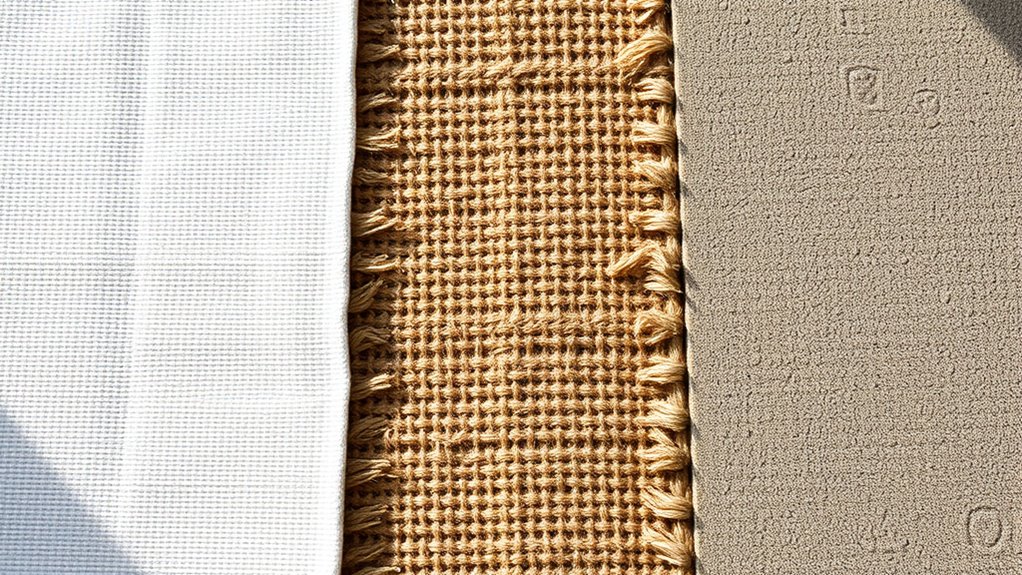
Durability and wear resistance are crucial factors to contemplate when choosing a rug backing, as they directly affect the longevity of your rug in daily use. Cotton backings tend to be softer but may wear out faster with heavy foot traffic, especially if not reinforced. Jute offers good strength initially but can fray or degrade over time, particularly in humid environments. Latex backings are highly durable and provide excellent resistance to wear and tear, making them suitable for high-traffic areas. They also maintain their integrity longer than natural fiber options. Additionally, latex’s jet propulsion technology exemplifies the importance of innovative engineering in enhancing performance and durability. However, latex can crack or peel after prolonged use or exposure to extreme temperatures. Your choice depends on your rug’s usage intensity and environment, balancing durability with other factors like comfort and sustainability.
Environmental Impact and Sustainability
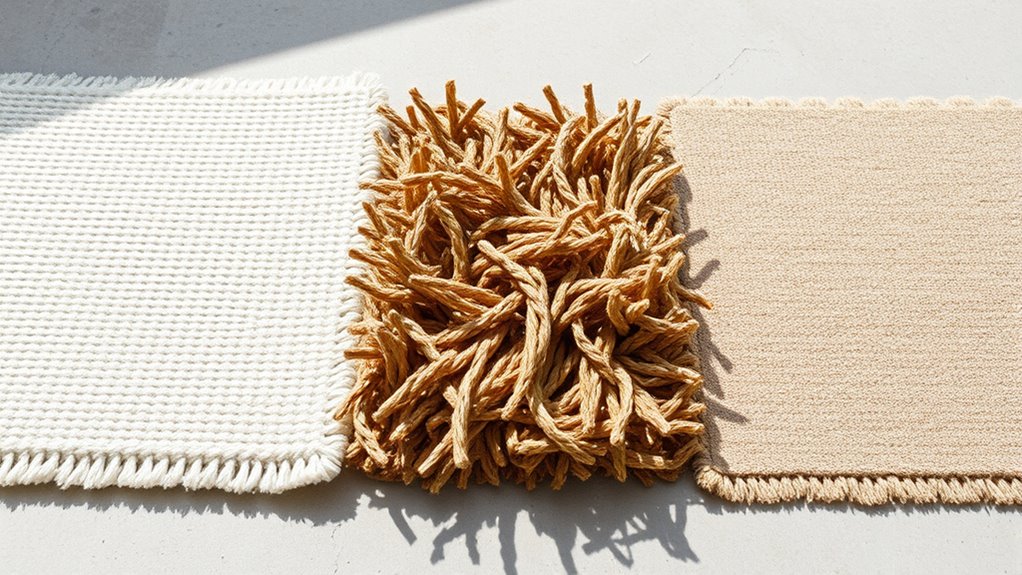
When evaluating rug backings, considering their environmental impact and sustainability is essential for making eco-friendly choices. You want to choose materials that reduce pollution, conserve resources, and support eco-conscious practices. Cotton backings are biodegradable but often require significant water and pesticide use during cultivation. Jute is a renewable resource with low environmental impact, yet it may involve chemical processing. Latex, especially synthetic variants, can be less sustainable due to petroleum dependency and chemical emissions.
- Opt for natural, biodegradable materials when possible
- Support suppliers committed to sustainable harvesting and manufacturing
- Weigh the environmental costs of processing versus raw material benefits
Making informed choices helps you minimize your ecological footprint and promotes sustainability in your home.
Comfort and Cushioning Factors
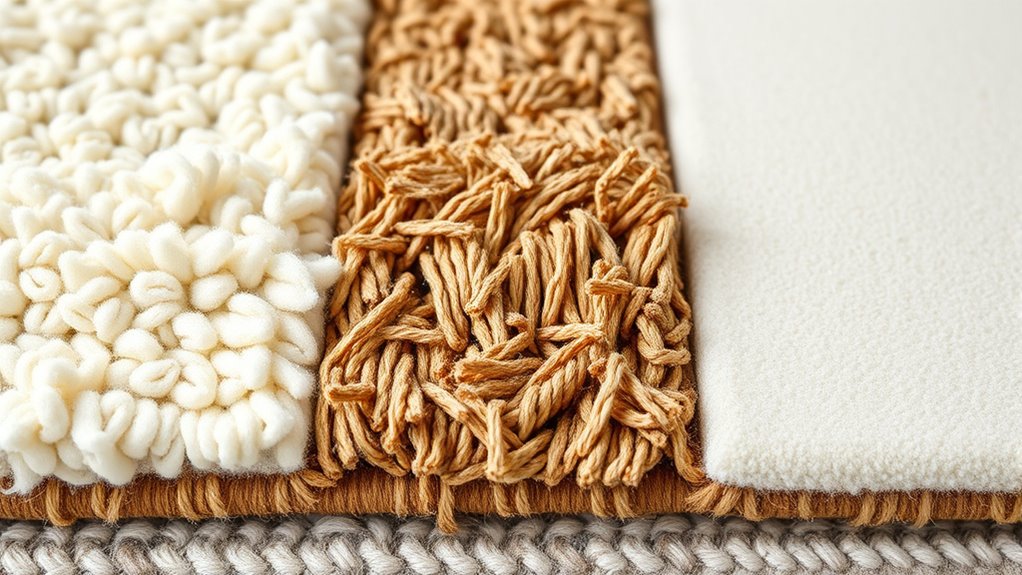
Have you ever noticed how a rug’s backing can influence how comfortable and cushioned your space feels? The backing material directly affects the rug’s softness and support underfoot. Cotton-backed rugs tend to be softer and more plush, offering a cozy feel that’s gentle on your feet. Jute-backed rugs are usually firmer, providing less cushioning but a natural, textured surface. Latex backing offers excellent shock absorption, making it highly cushioned and comfortable, especially for high-traffic areas. The cushioning level also impacts durability and comfort over time. If you prioritize a soft, cushioned feel, latex or cotton backings are your best options. For a firmer, more supportive surface, jute provides a natural and sustainable choice. Your choice influences how inviting and comfortable your space truly becomes.
Maintenance and Cleaning Considerations
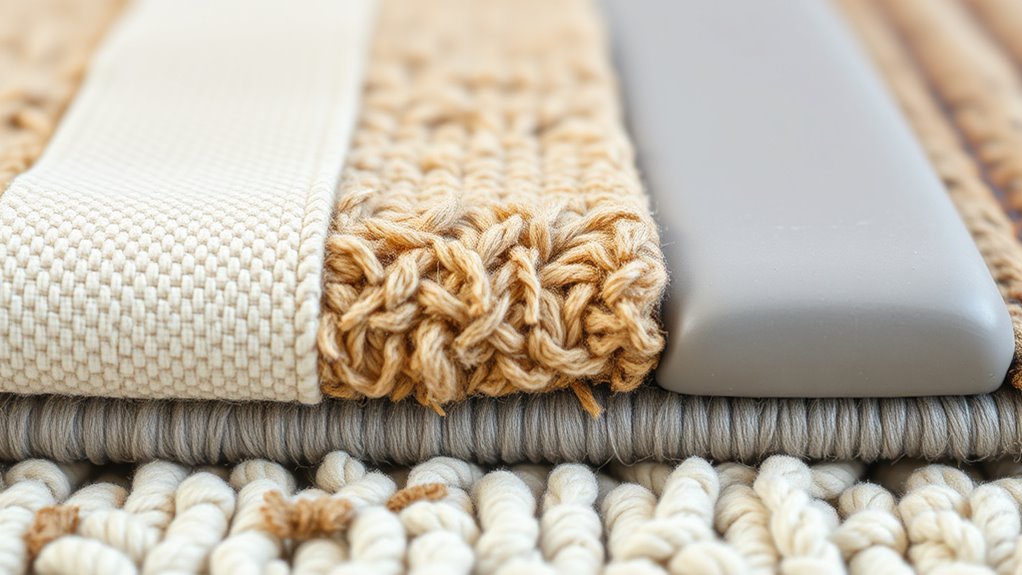
Maintaining your rug’s appearance and cleanliness depends largely on its backing material, as different types require specific care. For cotton, spot clean gently and avoid excessive moisture to prevent mold. Jute rugs need careful vacuuming without harsh brushes to prevent fraying, and avoid soaking them to prevent deterioration. Latex-backed rugs are resistant to stains but can be damaged by harsh chemicals; use mild cleaners and regular vacuuming.
- Regular vacuuming keeps dirt from embedding.
- Spot cleaning prevents stains from setting.
- Avoid excessive moisture to prolong backing integrity.
Understanding these considerations helps you extend your rug’s lifespan. Proper maintenance tailored to the backing material ensures your rug stays attractive and functional for years to come.
Best Uses and Suitable Spaces
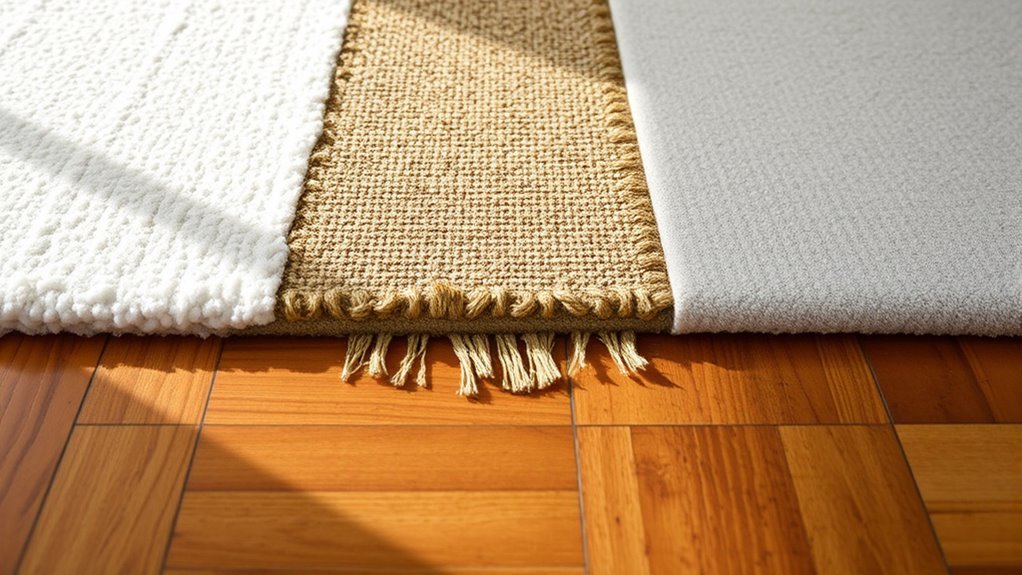
Choosing the right rug backing depends on the space and its intended use, as different combinations offer specific benefits. If you need durability in high-traffic areas, latex backing is ideal because it provides slip resistance and longevity. Cotton backings work well in bedrooms or low-traffic zones where comfort and breathability matter. Jute backings suit rustic or natural decor styles, perfect for living rooms or entryways, but they may not handle moisture well. For outdoor spaces, latex-backed rugs resist slipping and weather exposure better than other options. Consider your environment and foot traffic to select the best backing. For instance, a latex backing enhances safety in kitchens, while cotton adds softness in bedrooms. Matching the backing to your space guarantees your rug performs well and lasts longer.
Frequently Asked Questions
How Do Different Rug Backings Affect Indoor Air Quality?
You might not realize it, but your rug’s backing can impact indoor air quality. Some materials release VOCs or allergens over time, which can irritate your lungs or trigger allergies. Cotton backings tend to be more breathable and emit fewer fumes, while latex may contain chemicals that off-gas. Jute is natural and eco-friendly, but dust from it could also affect sensitive individuals. Choosing the right backing helps keep your indoor air healthier.
Are There Hypoallergenic Options Among Cotton, Jute, and Latex Backings?
Imagine a cozy room where you want a safe, allergy-friendly rug. Among cotton, jute, and latex backings, cotton is often the most hypoallergenic option because it’s natural and breathable. Jute is also good, but it can cause irritation for sensitive noses. Latex might trigger allergies if you’re sensitive to latex proteins. So, cotton provides a gentle, hypoallergenic choice, helping you breathe easier and enjoy your space comfortably.
What Are the Costs Associated With Replacing Various Backing Types?
When you consider replacing rug backings, costs vary based on the material. Cotton backings tend to be affordable, but replacing them may require more effort if they wear out. Jute is usually cost-effective but can degrade faster, increasing replacement frequency. Latex backings are more expensive initially, but their durability might save you money long-term. You’ll want to factor in installation, material costs, and how long each backing lasts to determine your best option.
Can Backing Materials Influence Rug Odor Over Time?
You might notice that backing materials can impact your rug’s odor over time. Cotton and jute, being natural fibers, may develop musty smells if exposed to moisture or dirt. Latex, a synthetic material, might emit chemical odors initially but usually doesn’t trap moisture. Regular cleaning and proper ventilation help reduce odors regardless of backing type, keeping your rug smelling fresh and extending its lifespan.
How Do Backing Materials Impact the Recyclability of Rugs?
Backings enhance the breakability and biodegradability of rugs, influencing their recyclability. Cotton and jute are biodegradable, making rugs easier to repurpose and recycle, while latex may complicate the process due to its synthetic nature. You should consider choosing natural, recyclable backings to promote sustainability. By selecting eco-friendly materials, you help guarantee your rug remains environmentally friendly, reducing waste and supporting a greener, greater goal.
Conclusion
Choosing the right rug backing is like selecting the foundation of a house—your comfort and style depend on it. Cotton offers softness, jute brings natural strength, and latex provides reliable grip. Consider your space, lifestyle, and eco values to make the best choice. When you pick the perfect backing, you’re not just laying a rug—you’re anchoring warmth and personality into your home’s soul, turning everyday spaces into cozy retreats you’ll love.
